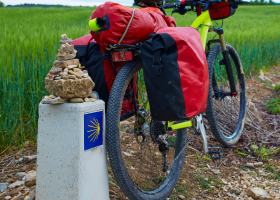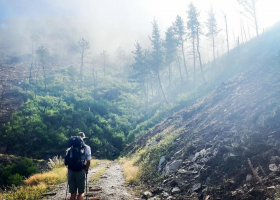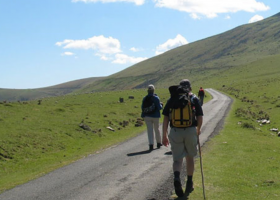
Create your own journey; Experience the best of Northern Spain at your own pace
This website uses its own and third-party cookies, for the proper functioning of the site and to generate usage statistics.
By continuing to browse we understand that you consent to our �ookie policy
Embark on the iconic Camino de Santiago cycling tour, a 700-kilometer journey from Pamplona to Santiago de Compostela. This isn't just a biking trip; it's an immersive experience through Spain's stunning landscapes, rich cultural heritage, and unparalleled gastronomy.
Start in Pamplona, renowned for its exhilarating Sanfermines festival, and pedal through the lush vineyards of La Rioja. Conquer the challenges of the Montes de León and immerse yourself in the historic ambiance of Santiago de Compostela in Galicia, a perfect blend of history and modern charm.
Prepare for a unique cycling adventure that connects you with Spain's breathtaking nature and rich culture. The Camino de Santiago bike route is an unforgettable exploration of Spain, offering a blend of spiritual, historical, and cultural experiences.
Click on "Request a quote!" (in the right-hand column) and receive a personalized, non-binding quote for your Spain cycling tour adventure.
Embark on the Camino Francés starting from St. Jean Pied de Port if you wish to experience the full route. This option extends your journey by 66km, offering a more challenging adventure.
The initial stage to Pamplona is demanding due to the crossing of the Pyrenees. This can be eased by either shortening the first stage to Roncesvalles or starting directly in Roncesvalles, thus avoiding the strenuous kilometers of crossing the Pyrenees.
✔ Daily departures throughout the year.
✔ Carefully selected hotels with private bathrooms.
✔ Personalized digital guide from Spain is More.
✔ Customizable stages: Yes, always.
✔ Excursion to Finisterre.
✔ Bike rental available.
✔ We recommend spending two nights in the cities of Pamplona, Logroño, Burgos, and León. This allows you time to immerse yourself in the culture, heritage, and vibrant atmosphere of these beautiful cities.
✔ Visit the Monasteries of Yuso and Suso, declared World Heritage sites in 1997. For this, you'll need an extra night either in Nájera or Santo Domingo de la Calzada.
✔ Explore the Monastery of Samos.
✔ Discover the Roman Wall in Lugo. An extra night in Sarria is required.
✔ Spend a day in Ribera Sacra to see the vineyards and enjoy a scenic cruise on the Sil River. An extra night in Sarria is necessary.
![]()
Click here to explore the Camino Francés:
Find key insights on distances, terrain, climate, and vital tips.
BIKING from Pamplona to Santiago
Camino de Santiago Francés (French way)

Arrival to the beautiful town in Navarra.

Mount Alto del Perdón (see picture) is today's biggest obstacle, but if the climb seems too hard, you will find a recommendable detour in our guidebook. But, despite the difficulty, it’s so worth it. From the top, you have a beautiful view of Pamplona and the Pyrenees in one direction and the easier upcoming stages in the other direction.
Today's stage ends in Puente de la Reina, which has a beautiful old town and a famous bridge from where the Camino heads west (The Queens bridge, Puente de la Reina).
A few minor but steep hills to overcome, especially in the early part of the stage. The route passes through lots of vineyards and there are several opportunities to visit wineries. Foto: Gracias a Rafael Llano.
Distance: 50 Km

Estella is a history-rich and exciting city with a beautiful old town. Today's stage begins with a relatively gentle ascent, but is relatively easy afterwards. There are several wineries along the way which can be visited, and a few of them also serve as excellent restaurants. There’s not much shade available on this day, so if you walk on a sunny day, it advisable to get an early start. Torres del Rio is situated on a hilltop and has a nice old town to explore.
A flat and easy stage compared to everything you've experienced so far. Several villages, but especially a single historical town along the camino, are passed. You will often walk surrounded by vineyards as the Camino welcomes you to Logroño and La Rioja.
Logroño is La Rioja's largest city and, of course, the center of a large part of the Rioja wineries. Along with a good glass of wine goes, of course, good food, which Logroño certainly can offer. The city's well-preserved old town is the center of countless delicious tapas bars.
Distance: 49 Km

Parks and the natural environment of the Grajera reservoir top off the stay in Logroño and open the doors to the soft Rioja landscape, filled with life and fruit trees. This stage will take you to Nájera passing through Navarrete, a town of pottery tradition and then on to Ventosa and the heights of San Antón. These hills offer unending views of rows of vines, a beautiful sight especially in September when the harvest has reached its peak.
Today the goal is Santo Domingo de la Calzada, a town in Rioja Alta. The route passes through the inviting town of Azofra. This route due to its proximity to Castilla is surrounded by a landscape of hectares of grain. On the other hand, Santo Domingo itself is a vibrant town. There are many restaurants with delicious food and a very well preserved city centre that attracts many tourists all year round.
Distance: 49 Km

Today the Camino enters Castilla y León. From now on, for a couple of weeks, you will pass through the widened passages of the “Meseta Castellana” Castillian plateau. The closest objective is Belorado, located in the shade of a peak where old caves of hermits and ruins of a mythical Castle still remain.
The following stage passes through several interesting monuments such as the Virgen de la Peña church excavated from the rock and some very well located castle ruins. This part of the journey passes through hillside landscapes and extensive forests (the last before reaching León, and if you have chosen to continue walking from Leon to Santiago, you will not see true forests for approximately 300 km.).
The first leg of the trip passes through a small pine forest before seeing the outskirts of Burgos. Burgos was founded in the year 884 and its historical patrimony is evident from this.
The city is filled with monuments and with a gothic cathedral that acts as its crown jewel. In fact, the cathedral of Burgos became a UNESCO World Patrimony site in 1984. Overall, Burgos gives a medieval sensation, completed with its inviting tapas bars.
Distance: 71 Km

Today we enter the unpopulated plateau where you only be accompanied by your own shadow and strength, discovering landscapes and almost medieval towns that award the Camino the legend that has been embedded in it since its beginning.
This day, without tree coverage from the elements - be it the summer sun, the penetrating winter cold or the uncomfortable wind -sticks in your mind, along with passing under the arches of San Antón, the visit to the Castrojeriz and the later climb to the Teso de Mostelares. From this hill the brutal "Tierra de Campos" opens up to the pilgrim, a region proud of its grain, pigeon flocks and valuable art.
NOTE: The stages of days 8 and 9 can be divided in 3 if the distance appears too long to you.
Distance: 65 Km

In this stage the plainness and monotony of a walk takes over the walker passing through the core of the countryside. In the final leg you will find Santa María la Blanca church- a stronghold attributed to the Templars.
Today you can visit "Monesterio de San Zoilo" that is found on the outskirts of Carrión de los Condes (if you reserve your trip enough in advance it is possible to stay the night at the monastery).
The route continues through unending fields until you reach Sahagún, an important pilgrimage place with places of interest like monasteries, churches and a fantastic Roman bridge.
Distance: 76 Km

Grain, corn, sunflowers and numerous other crops provide color during this stage. Here you can see eagles and storks and although this stage is flat and a little boring there is lots to see. The route passes through several typical towns that probably wouldn't exist if it weren't for El Camino.
Today a tree lined path will take you to Reliegos y Mansilla. On the way you will see many cellars that appear as caves carved out of the hills. These were traditionally used to mature wine, but today these traditional cellars are far from wine manufacture, hence many of them are used for restaurants or private reunion areas where friends meet. Examples of this can be found in the small town of Reliegos.
Today you will go to León. The first few kilometres after Mansilla are pretty nice although later they pass through the industrial area of León, (for which reason some chose to take the bus).
Once you have reached Leon, when you first set eyes on the cathedral you will know that it was worth every step of the journey.
This old Roman capital is one of the main towns of the pilgrimage. In 910 León was the capital of the kingdom that later became the Spain that we know today. The medieval importance of the city is reflected in numerous monuments such as the San Marcos y San Isidoro cathedral where several old kings are buried.
The town is filled with tapas bars and inviting places from which you can admire sore-footed pilgrims walking around with the hope of reaching Santiago in this journey or the next.
Distance: 38 Km

The Camino leaves Leon through the beautiful Roman bridge, next to the Hostal de San Marcos, now a National Parador. The first 8km are through the industrial zone of Leon. When this segment ends, however, the stage before you is relatively flat and becomes more beautiful with each step. There is also a much more attractive alternative path to this route that you can read about in the guidebook you will receive before your departure.
The main treat along today's stage is the Roman Bridge of Órbigo Hospital. Enjoy.
When you approach Astorga you will see the mountains in the backdrop that you will be crossing over the next few days.
Astorga is a very beautiful town with many memorable monuments such as the Episcopal Palace made by the great Catalan architect Antonio Gaudí. Do not forget to try the Maragato cuisine as well as Astorga's famous pastries, merles and hojaldres. In the guidebook we give you some examples of restaurants you can visit to taste this characteristic cooking.
Distance: 50 Km

This day has a mountainous flavor. You'll pass by the famous iron cross (Cruz de Ferro) where pilgrims traditionally leave stones from their home towns at the base of the cross. Along the way to Molinaseca, the wondrous natural scenery is marked by a few villages. Molinaseca is crammed with charming restaurants frequented by pilgrims, and also many locals, enjoying the city’s streets and cozy cafés.
Distance: 46 Km

Start the day passing through Ponferrada which has a famous castle in the town center, Castillo de los Templarios, a 12th century Templar castle. Ponferrada is a large Camino-city with a population of over 60.000 - known for its large iron and coal reserves. Later you’ll pass through Cacabelos, a once important medieval pilgrim stop, today home for a large number of wine-bodegas. Then it’s on to Villafranca del Bierzo, often known as the “other” or “little” Santiago. We’ll pass by the 12th century Romanesque Church of Santiago and its north entrance Door of Forgiveness. Villafranca del Bierzo is a pleasant village in the middle of Bierzo, which has gradually established itself as one of Spain’s thriving wine regions. Villafranca del Bierzo is on of the most pleasant towns on the Camino.
Distance: 48 Km

Today you'll walk along ancient paths shaded by birches, oaks, chestnuts and poplars up to the emblematic mountaintop village of O’Cebreiro, with a lovely 12th century Romanesque church that is the scene of a fascinating legen, and curious ancient straw-roofed dwellings called Pallozas. This path offers some of the most panoramic views, but is also one of the most challenging stages. Often shrouded in mist, the small stone village is extremely charming. If you arrive on a clear day, the views are dazzling!
After a lot of uphill on yesterday’s walk, today will be mostly downhill. We’ll again have many splendid views of the surrounding countryside. On todays walk you'll also start to notice stone granaries called horreos. You’ll also notice that the weather changes a bit, as we’re now subject to the winds, and rain, from the Atlantic Ocean. Also, the name Triacastela means “three castles”, although none of the castles still exist today. The limestone used to build the cathedral in Santiago came from quarries near Triacastela.
The landscape begins to change as you walk more downhill, perhaps a welcome relief after the last few days of hilly terrain. There are two routes to Sarria, and its recommendable to visit the Benedictine Monastery of Samos, founded in the 6th century and one of the oldest in western Christendom. From here its a idyllic hike through the forrest to Sarria.
Sarria itself is a town of about 13,000 residents and is the last place pilgrims with limited time can hike the minimum distance to the cathedral in Santiago, 100 km, to receive the certificate of completion on the Camino. Because of this, Sarria is a major starting point for many pilgrims. You’ll notice an increased number of fellow pilgrims from here to Santiago.
Distance: 50 Km

Galicia is one of the prettiest regions in Spain, both in nature and tradition. During today’s hike, you will become acquainted with its glorious traditions. Today’s walk is one of the most attractive stages of the entire Pilgrim’s Way; traveling through verdant forests, grassy meadows, fertile orchards and simple stone-built hamlets.
The terrain becomes flatter, though still hilly. Optimism takes over in this magnificent, lush area. By now your goal feels achievable. The journey continues along farm tracks and quiet country roads through the lush Galician countryside to Palas de Rei. Palas de Rei is a small village of around 2,000, with an illustrious past although nothing remains today as a reminder.
Distance: 47 Km

Today's views will seem somewhat familiar. A typical day on the Camino de Santiago, through rolling green landscapes, dotted with cows, stone walls and tiny Romanesque churches. Take time to talk and learn about myriad of legends and stories that this route offers.
An exhilarating atmosphere unfolds as your journey's end draws closer. Pilgrims now feel their goal, and begin to revel in happiness and relief with the many companions they met along the way. Today’s walk finds us on natural pathways through groves of tall Eucalyptus that provide superb shade for our steps.
Congratulations, you achieved an admirable goal, so it's time for a number of traditional pilgrimage rituals. First, be sure to get proof of this feat: the last stamp in your pilgrim passport. Along with the rituals, enjoy the End Station of the Pilgrim route, Santiago de Compostela, which offers a veritable cornucopia of attractions and one of the world’s most important cultural centers. This university town exudes charm and has a myriad of cozy streets offering ample opportunity to sample the many local delicacies. The cathedral is surrounded by a historic center which is on UNESCO’s World Heritage Site list, and old town is incomparable. Its monuments stand as true works of art in different architectural styles.
Distance: 67 Km

True pilgrims continues further and finish their journeys in Finisterre. The tour goes by bus with an English-speaking guide from Santiago to Finisterre in the morning and returns mid-efternoon to Santiago. Just off the stunning, rugged coastline and the fabled “Costa de la Muerte” (Death Coast), a reef filled with shipwrecks and tales of legends captures a raw, natural beauty. On the coast’s westernmost point is Finisterre – meaning the world’s end. Romans named this coast because it was literally the end of the known world. For many pilgrims this is the symbolic endpoint of the pilgrimage.
The evening is spent in Santiago de Compostela.


Pilgrimage by bike through incredible landscapes
9 days / 8 nights
From 850 EUR/pers.

The last 2 weeks of Camino del Norte from Avilés to Santiago; Amidst Greenery and Sea.
17 days / 16 nights.
From 1190 EUR/pers.

Pilgrimage from Oviedo to Santiago through breathtaking landscapes.
16 days / 15 nights
From 990 Euro/pers.

Pilgrimage from France to the vineyards of La Rioja crossing the Pyrenees
9 days / 8 nights
From 650 Euro/pers.

Results of research into the psychological benefits of a camino announced

njoy the Camino with the best planning